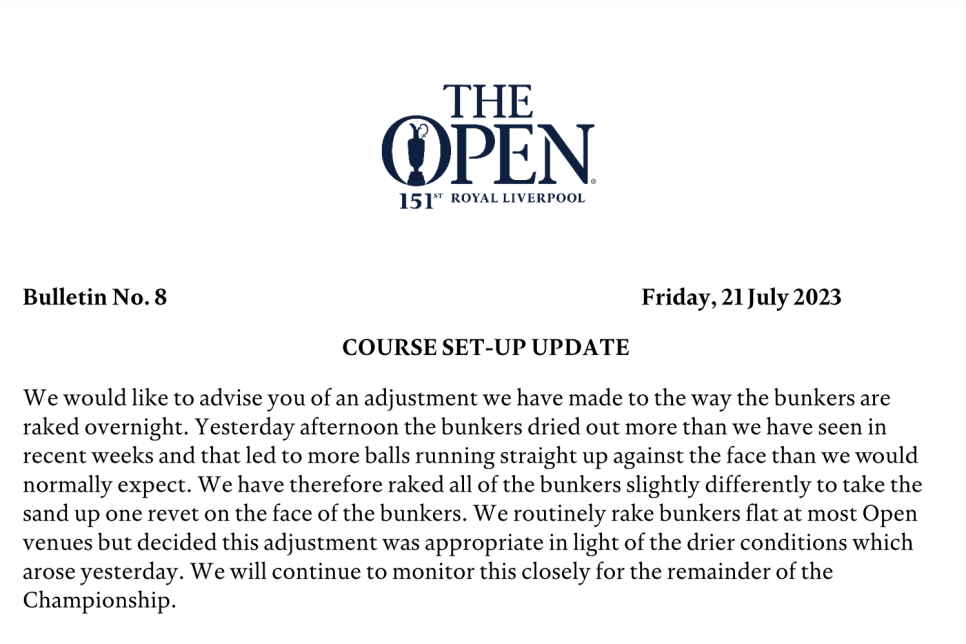Hoylake, England. Through the halfway point of the 151st Open Championship the main headline starts with the splendid play of Brian Harman. Shooting the low round of the day with a 65 and ending his play with a brilliant eagle at the final hole. How good was his round? Just over 8.5 shots lower than the second-round scoring average.
But right behind that story is a topic causing even more concern, anguish and frustration. The bedeviling bunkers found at Royal Liverpool. There are a total of 82 bunkers and each is akin to a minefield. Players can find a wide assortment of lies and stances from which they need to improvise in order to escape — assuming they can.

Much has been made of the manner by which the bunkers have been raked for the event. Instead of sand pushed higher along the far edges as is the case during normal member play, the sand has been pushed flat, and, as a result, balls finding these pits can mean an array of difficult stances and lies.
In some cases, that has meant players going backwards away from the hole. For those who have attempted bold escapes the failure to execute can mean a number of frittered away shots.
The challenge at Hoylake is deciding upon a line of play when you step onto any of the teeing areas.
Players can opt to stay behind the bunkers but in doing so are left with far longer approach shots to the greens. Going into the targets with increased yardage can mean far fewer opportunities to get close enough for birdie tries. This was the strategy carried out by Tiger Woods when claiming his third and likely final Claret Jug. But during that victory Woods displayed an iron dexterity that rates among the best ever seen in major championship play.

The flip side is attempting to pass or fly over the bunkers in the fairway with one’s driver. That option is fraught with even more peril as bunkers can serve as a magnet pulling the ball into the foreboding abysses.
The R&A after seeing the carnage issued a statement indicating an action would be taken but by no means does that lessen the peril and punishment bunkers can inflict for the careless golfer.
For many years bunkers have provided a safe haven for accomplished players to use for additional spin when attempting to get near a pin position leading to par saves becoming predictable outcomes, and, in a number of instances, players routinely holing out shots.
This is especially so for players on the PGA TOUR who have become conditioned to expect routine escapes from bunkers. Links golf views bunkers in a far different manner. They are rightly seen as traps from which the wherewithal to escape is anything but certain.
Players have to honestly examine the risk in attempting to advance the ball beyond a certain distance. False bravado can quickly mean a deflated ego as the ball remains within these coffins and the player then must regroup to salvage even the least bit of sanity.

Related: Brian Harman hunting major breakthrough after surging clear / Scores
While Harman commands the top position with 36 holes to play it is worth noting that nothing can suggest a smooth and predictable pathway to the Claret Jug. Weather patterns are forecasted to change noticeably for the weekend rounds.
Players making the cut at +3 are well aware major scoring swings can take place with two rounds to go. There is not only the sting that the bunkers can provide, but also the internal out-of-bounds that can happen on a few holes at Hoylake — most notably the par-5 18th.
Royal Liverpool has once again shown the merits of its challenging design. The upper echelon of players do not favor humiliation but they are fully cognizant of what finding any of the bunkers can mean.

Was the R&A correct in taking an action in the midst of the event? That will be a hotly debated topic. However, the connection to links golf that happens each July should have made players keenly aware that the predictable outcomes they have been accustomed should have been checked at the door upon arrival for this year’s Open Championship.
When The Open first started in 1860 the fear factor in finding one’s ball in these cruel torture chambers was something all knew could happen.
That fear has now returned and commands a front row seat at this year’s championship.
Rightly so.

